Note that these concepts are for discussion, and to generate a
new angle to solving a problem. This is not always a best
solution, but tags the multiple directions of investigation that could lead to a solid
discovery. -- "Fuel for Thought"
Motor Control Circuits - Can we get a better electric motor for cars?
Something that was researched and never built, was an external rotor
motor that would be the wheel of a car. With a larger rotor, the
torque is the same as gearing down. The speed can increase by
frequency to a limit before it becomes inefficient from hysteresis, but reducing the
phases to reduce the frequency, could be like shifting gears. There
might be less torque, but higher rpm
and less current by switching a large rotor from 5 to 4 to 3 phases and maybe less. This is much more efficient, and can be used as a supplement to a hybrid
car. The car can effectively run with a small hp - 20 to 50
and mechanical or hydraulic drive supplemented with electric wheels on a
different pair. The takeoff and acceleration is boosted by the rotor wheels, as the
primary drive is mechanical. One negative to this concept is the complications of finding a bearing
system that can handle the road impact and stresses while maintaining a
minimal gap, for a large external rotor requires
high speed bearings in a sealed environment. That could be the
hurdle that is too high to reach.
An alternate tool to provide the same effect could be that same
large rotor scheme in the drive train, and not on the wheel. A supplement driving motor in a duel automatic clutch drive system, like
an overdrive clutch bearing. That clutch can set idle and kick in
when needed to supplement the torque, like the pedal drive on a bicycle. It would need a low torque start until it engaged the driving speed, and
then give the boost force to compensate for a smaller fuel engine.
Modes could be set to keep the rotor up to speed or allow it to remain
idle, thus not wasting energy on the centrifugal torque to keep the
rotor spinning.
There are two primary opposing forces to a vehicle on a flat
plane at a constant speed. One is wind resistance, that is reduced
by hydrodynamic design (not aerodynamics) that reduces impact AND drag
pressures. Aerodynamic and hydrodynamic results are essentially
the same, but the hydro tests give a greater visual concept of flow that
can easily be missed or dismissed in computer generated calculations. The car designs that are used today have government mandated squared or
flattened backsides to act as a drag-chute and keep it going straight
and correct a spin. But dragging the air is identical in
drag-force to pushing the air with a square front. You can see
that on a hydro test, but it is dismissed on an aero test. That
"pulling" force is precisely how a wing lifts an aircraft, only it is
vectored to reduce drag, have
you ever seen a square back aircraft?
Aerodynamics is one force, but one that can be as bad or worse
is the rotational centrifugal force by each wheel and tire. Have
you ever tried to spin a bike tire fast? This can only be reduced
by decreasing weight, speed, or diameter. If the rotor wheel were
on a large stator, the stator does not spin and the outer rotor wheel
could be thin enough to hold a tire and massively reduce the spinning
weight.
All these and many other concepts could be best tested in a
supportive environment that would fuel the experiments. One of my
schemes of imagination can envision something like the Indianapolis-500
mile race, but limited to 5 gallons of fuel. They could start at
20 gallons, and any efficient car could make the finish at a reasonable
speed. Hitting 100+ speed requires additional torque for the whole
distance, but that would turn the race into a pure engineering test of
efficiency, and less on the influence of driver jostling skills.
One of these days it might get back into my "to-do" list.
Solar Panels - What if your car were a solar panel?
Solar cells are funny looking plaid prints on a plate of
glass, very thin and brittle and basically a three layer bi-junction
transistor. That might be stylish for a geek,
but not very practical to use on anything that cannot be protected from
impact, and
the protection usually reduces the effectiveness of the power. They are also expensive, but can be replaced if the mounting design
allows this. A total electric car would take about 2k to 5k watts to
operate a 2 thousand pound car that is about like a Volkswagen Bug. That kind of power would take about six each, 4 foot by 8 foot sheets of solar
panel to run without a battery drain. You can see why they have
large batteries and a generator to charge them. The other problem
is the batteries have a short life compared to the vehicle. They
only last a few years and replacing them is - Wow - half or more the cost of the
car.
All we can do is improve or add to, what we already have
available. How about a hybrid solar panel? Use the
traditional panel wherever possible for their relative efficiency. The rest of the car needs a special layer of primer coating that would
turn all painted surfaces into thermocouples. The base metal, bonded to a
dissimilar metal generates power and increases voltage with heat. You could power from heat of the pavement (submitted by a friend in
Texas, John English). This would be useless in cool temperatures, but that is
why it would be in addition to solar panels that are useless in the dark. There are complications with this magic formula, of corrosion and
circuitry isolation. Any dinged area will probably corrode easily
and cause a short,
and the circuit connections might be tricky without shorting the
membrane of the coatings. What if a three or more layer thermocouple
system was used? That might reduce the corrosion factor, simplify connecting the membranes,
and increase the potential by stacking like a Silicon Rectifier.
This is one of my garage experiments
that have not yet gone off the drawing board, but it seems to have some potential. Can this be done with paint instead of electroplating? Knowing chemistry better would help
find the best materials for making conductive paint with the highest
valence potential, but many of these
experiments are only to prove a theory. The efficiency and technical refinements are
usually done through industrial production teams with greater resources.
Some day we'll have a good answer, keep trying.
Electric Cars - With a new kind of Battery.
The Lead-Acid batteries are extremely powerful and efficient
as they are. One main condition that kills them, is the conductive
gunk that settles to the bottom of a battery will eventually
interconnect (short out) the plates. The killer buildup of gunk is inevitable because the batteries are not made to be disassembled
and cleaned out. There are several good reasons that they are not
serviceable. The batteries are full of a very hazardous chemical,
and you really don't want to mess with it. But if the sludge could
be removed, the battery vibrant life could be 10 times what it is for now, and
that takes packaging design. There are several possibilities for
this approach, but the formation of a container is not in my scope of
capabilities. Handling such hazardous chemicals takes a dedicated
space and equipment, but smaller scale experiments can usually be
tested.
Another killer for batteries is the condition of overheating
or freezing can warp the container or plate mounts. They can handle a lot, but if they warp
just a bit, then the metal structure inside can be stressed enough to
break or crack, which causes an arcing junction and that extends the fracture
to a
plate or the connecting rods that tie all the plates together. That is an unrecoverable failure in a battery, but some designs are much more durable than others,
and thus more expensive.
This is purely a design function of re-evaluating the simple
structure of a battery, and adapting a rejuvenating system into the
container. Can we design this by committee? It can be done
if the EPA and few other overseers and watchdogs would get out of the
way.
The Battery A
contribution from Shermie Wehe, a long time friend that started this
website
The-Battery.pdf
What is involved to produce a Battery.
Computer Interface - !
For those of you who remember
MFM, RLL, & IDE, Hard Drives and what a pain it is to get the setup
info; this 87 page
Hard Drive PDF might come in handy, as
it does for me. But there are still a few unknowns at times.
Here is a handy document in
PDF form and in JPG form. From National Electrical Code, this tells what
size of wire is needed for known ampacity (current) and Circuit breaker
sizing (1997)
NEC-Ampacity
PDF
NEC-Ampacity.JPG
Radio Communications - keeping in touch with a group broadcast.
These are Don Moore's Ham
Radios

Independence Kansas Ham Radio
Club Radio-NØID http://www.theorybin.com/Radio.htm
See many more photos and Radio specific links and Club events at the Radio-NØID web page.
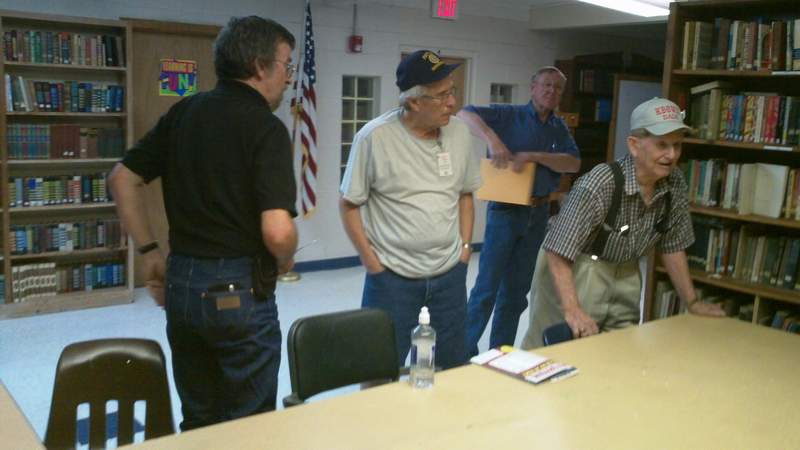
Breaking up after a doughnut meeting.
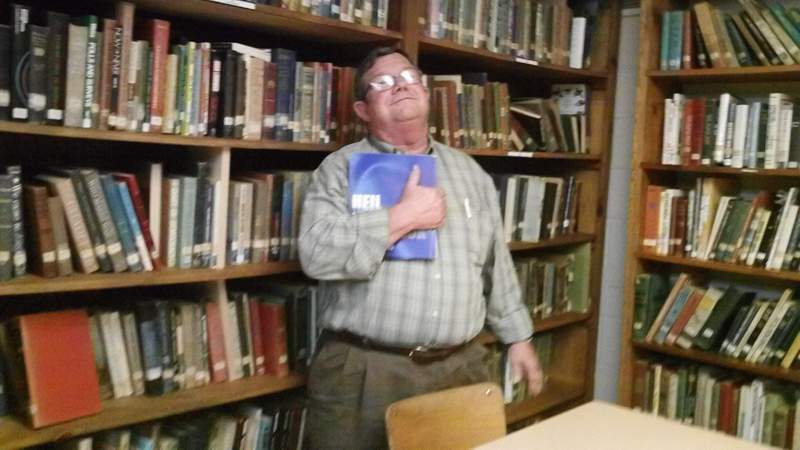
Don hams it up.
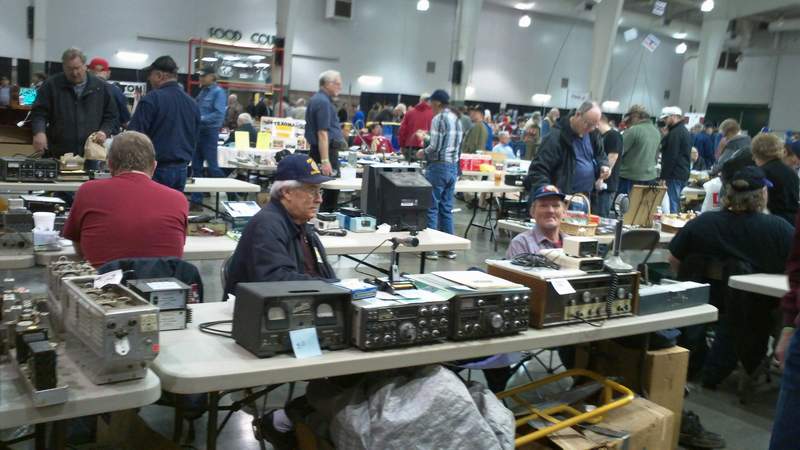
A few photos from the Green
Country Ham Festival 3-18-2014, where Don Moore has some of his gear out
for sale. Things have already been picked over, for this is only half of
the gear that he started with. We all had an interesting day in
Claremore, Oklahoma.
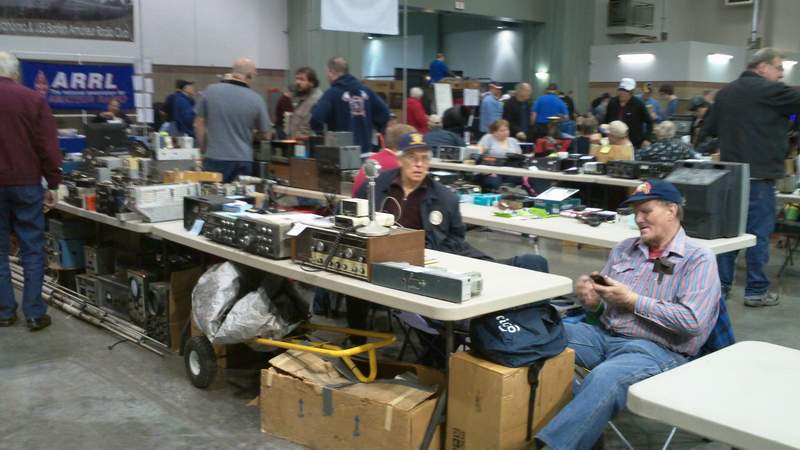
Nonstop chats with curious
strangers and oodles of things to gawk at including a few celebrities of
the technology side of the world. We even won at a drawing for a YAESU
FT-60R handheld transceiver.
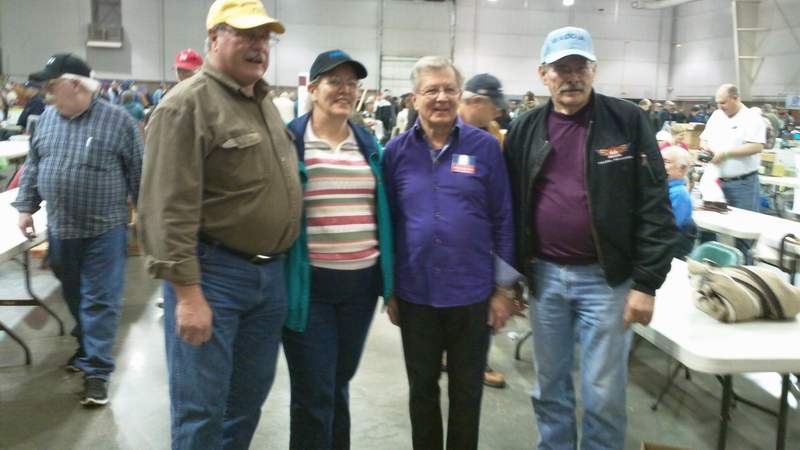
This is Bob Heil, the primary announcer of Ham Nation K9EID and some of his perpetual crowd. We have one of his books for sale at the Independence Radio Club. Heil Ham Radio Handbook second edition, that covers many of the basic questions of ten to two meter operation.

The Indy Radio Club had a
presentation of the Aerial Imaging Systems by AgEagle. Click on the picture to get
to a page of a dozen photos of Bret Chilcott's meeting.
History of Car Radio! A
contribution from Dale Russell KBØWIZ
Car-Radio.pdf
Radio Images - What if your radio could display a picture?
My Radio Project is essentially an add on circuit for FM Radio stations
and receivers. This circuit will enable the radio stations to send
an image during their broadcast that could enhance their usage. It does not change the transmission signal or receiver signal of the FM
radio. No changes will be necessary to unmodified equipment.
The modified transmitters and receivers will have an added signal
that will not be "visible" or effect unmodified equipment. A
standard receiver will work fine when tuned to a modified station. The new receivers can have the feature to extract and display the added
signal, or an older receiver can have a modification kit added to
receive the additional signal. The transmitting and receiver modifications have been
successfully tested on high end modern equipment and even a mono tube type receiver.
The refinements of screen interfaces can be easily implemented, but are not
in my personal collection of skills.
What is the purpose of this device?
During music play - the CD cover image displayed, would help to sell
the music by visually identifying the Artist and source CD image.
During advertising - a map to the store or image of the
house/car/item that is advertised.
During Talk Shows - an image of the announcer or display of
informative
text or Radio Station logos.
During News periods - a map of traffic red zones, or
people and places of the
news event.
These are just sample ideas of what can be useful during a broadcast.
The image selections would be up to the Radio Station to choose and send.
The receiver would get an image with about a 7 to 20 second delay
depending on if b/w or color image is selected. This is inadequate for
video, but excellent for still shots. There could even be a
programmed display save buffer, to tab through or hold previous images.
That delay can be reduced by using a patented system by Motorola, that
would give less than 2 seconds for each image. That could buffer a brief
video if needed.
The technology for getting this system to work is in the design and
testing phase
at this time. The transmitter modification works, but needs
refinement and a computer feed with smooth interface. The receiver
kit is on an elaborate circuit board that could best be developed on a
microchip. The memory storage and other add on functions can be
designed best with programming skills that I lack. More notes will be available after patents are
acquired.
Some feedback has noted that this is already available in
cell-phones and satellite radio.
Yes, there is some visual on those devices, but radio stations
are common. At any populated area of the world, you can receive a
radio station signal in your car or home. Imagine a radio in your
car or home or work, that has an image of those mentioned above. This would not be like satellite radio that has a monthly bill for the
reception, and the same with a cell-phone or internet link.
This would be standard free airwave signal reception over the
standard FM radios that we all have. There would be no change of
anything except an add-on circuit for receiving the images.
What do you think? Feedback to the Author of this site.
Some Useful Websites
For Electronics
All About
Circuits - - Articles and Video training
Electrical
Engineering online community that provides both interesting
content and useful resources for Electrical Engineers. http://www.allaboutcircuits.com/
(recommended June 7, 2018)
EE-Power - -
Digital Publication of power electronics
industry. Technical articles, Design tips, Application notes from leading
engineers.
https://eepower.com/ (recommended June 7, 2018)
Maker Pro – Programming
Active open source platform for projects on Arundo,
Rasberry Pi, Intel Edison, Home Automation and more. Completely user
generated content.
https://Maker.Pro/
(recommended June 7, 2018)
http://www.radio-electronics.com/ Basic Radio
Tutorials and Circuits
http://www.designnotes.com/ Design Circuits
http://www.uoguelph.ca/~antoon/
Electronics Tutorials & RC Circuits
http://www.embeddedlinks.com/chipdir/
Chip Directory
http://www.pcs-electronics.com/guide_schematicsnew.php Mighty's FM Radio Shop
http://scientificsonline.com/Default.asp?bhcd2=1191490886 Edmund Scientifics
http://www.onlineconversion.com/ Physics Conversions
http://www.htmlcodetutorial.com/ HTML Code Tutorials

This is the annual chart for 2016 from the
Startlogic Statistics of Theorybin.com.
Notice that I do not get a large viewing like
some sites report. My visits for the year are near the daily count for some
sites. Theorybin is the link for knowledge and interesting studies. This is the
only site for much of the biblical research that is offered, and will maintain
and add information as long as I can.